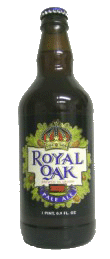Royal Oak Pale Ale
Review Date 5/18/2004
Try?
Re-buy?
If you’re a beer enthusiast, you’ve likely
heard of the English brewing concern Eldridge and Pope. They are (or
more accurately were) the folks behind that Holy Grail of the beer world,
Thomas Hardy’s Ale. Bottles of that brew are still floating around out
there, and if stored properly the beer improves with age. So you can still
experience its splendor if you haven’t already.
Another beer Pope produced which was also highly prized by beer barons
everywhere was Royal Oak Pale Ale. Though not as powerful a brew as
Thomas Hardy’s, it had a character and class all its own. And although it
has been many years since Royal Oak has passed my lips, I remember it fondly
all the same.
Pope stopped brewing both of these beers some time ago. But wait. Our story
is not over. That’s because both beers are being re-created by O’Hanlon’s
Brewing of Devon, England. They are following the original recipes to be
as authentic as possible, though with the Royal Oak they’re adding a twist:
bottle conditioning.
Bottle conditioned beers have live yeast in them, so that the beer is still
evolving over time. This helps protect the beer from oxidation, too, acting
as a preservative.
How did Royal Oak get its name? We’ll allow O’Hanlon’s to explain.
The Royal Oak legend relates how King Charles II narrowly escaped capture
by the Parliamentary army after the battle of Worcester in 1651. The future
king and a loyal general hid in the branches of a great oak for a day and a
night while Cromwell’s Roundheads searched in vain below them.
And there you have it. I’m not entirely sure how good king Charles and his
friend the general dealt with the boredom of being stuck up in the branches
of that Royal Oak tree. But I suspect that their time would have passed more
agreeably had they been supplied with an ale as fine as O’ Hanlon’s version
of Royal Oak Pale Ale.
Royal Oak Pale Ale pours to a bright orange color with a thick rocky
head formation and a very rich and fruity nose. A good dose of Brussels lace
follows the liquid all the way down to the bottom of the glass. The first
thing you notice in the palate is the malt-thick, caramelly, a little chewy.
Amazing.
Then, the subtle nuances of the beer start to emerge. A little buttery
flavor at first, then the delightful fruitiness, and gradually a long, dry
herbal spiciness reveals itself into the finish. The bitterness is nicely
pronounced but not overly so; it gently lingers on the tongue.
There’s a wonderful balance between malt and hops here. I love the gentle
drinkability of this delicious real ale. If you can’t pop on down to the pub
for a pint of cask ale, you can always bring the pub home with you in the
form of Royal Oak Pale Ale.
It’s not as good as the original. It’s better.
And remember, try a new beer today, and drink outside the box.
*Pricing data accurate at time of review or latest update. For reference only, based on actual price paid by reviewer.
(B)=Bottled
(D)=Draft

